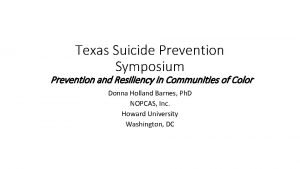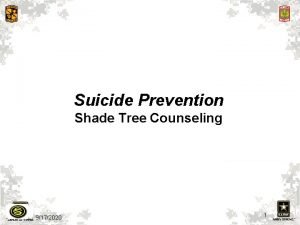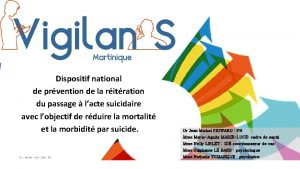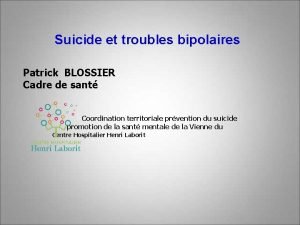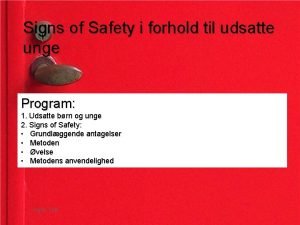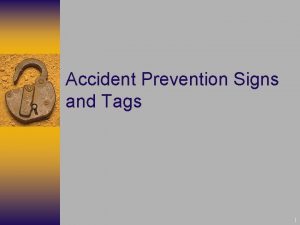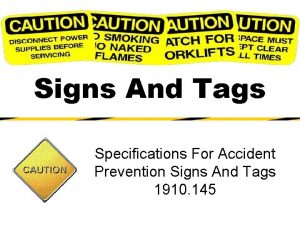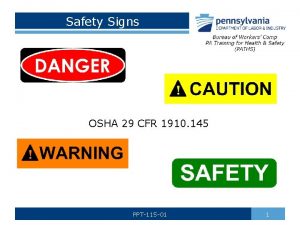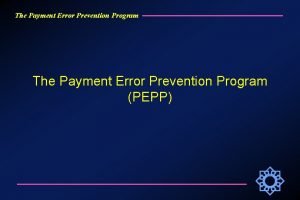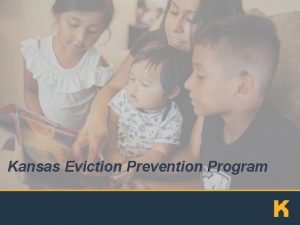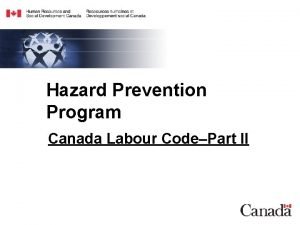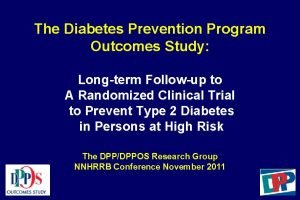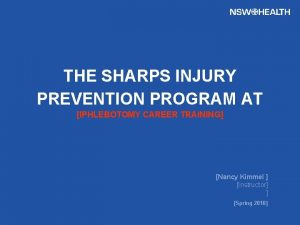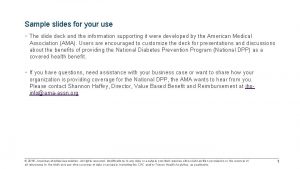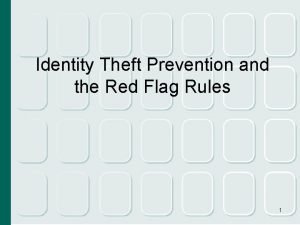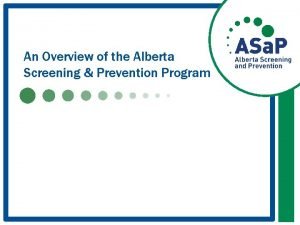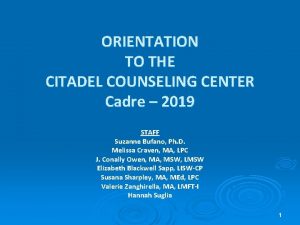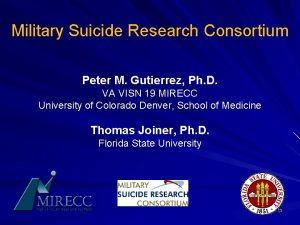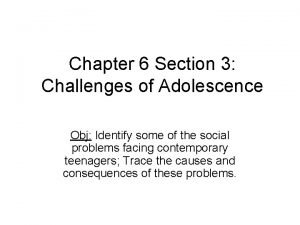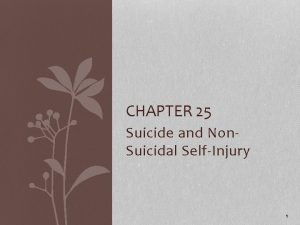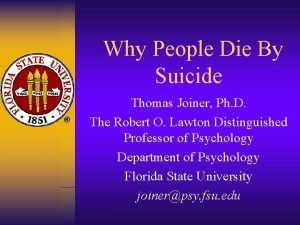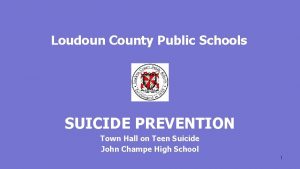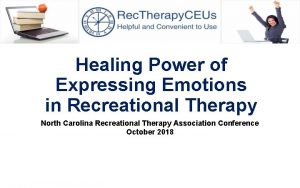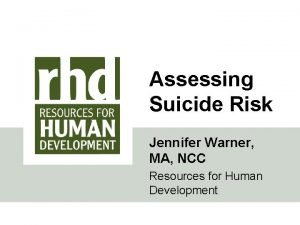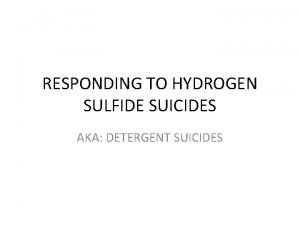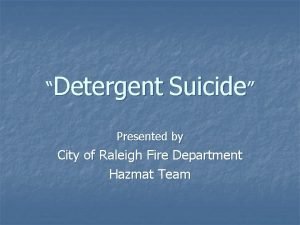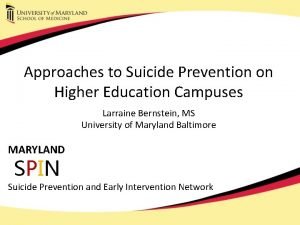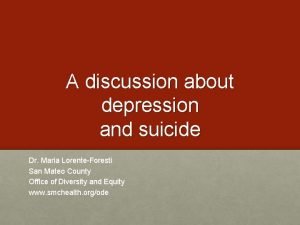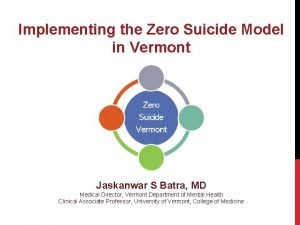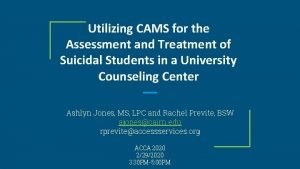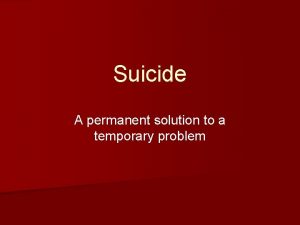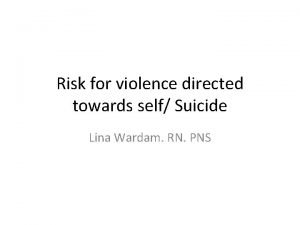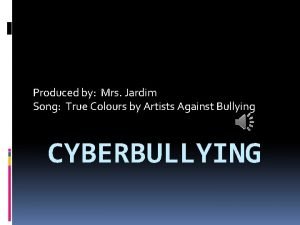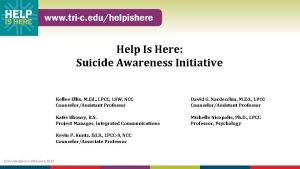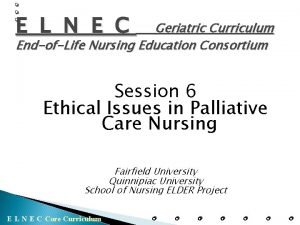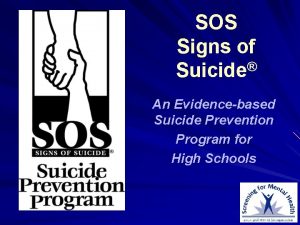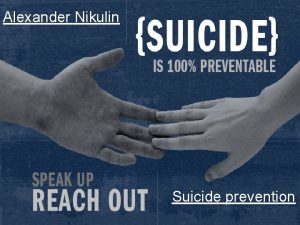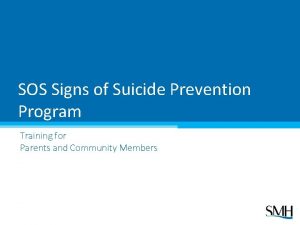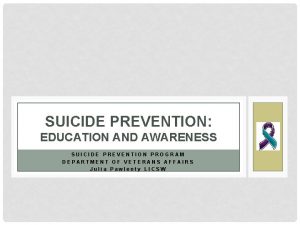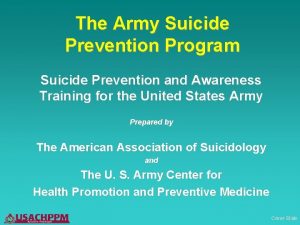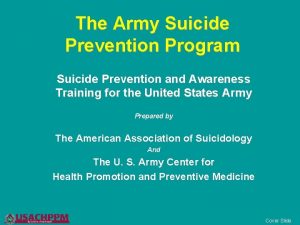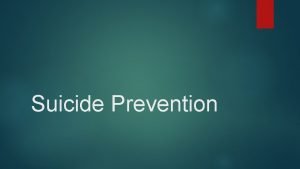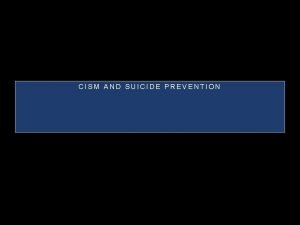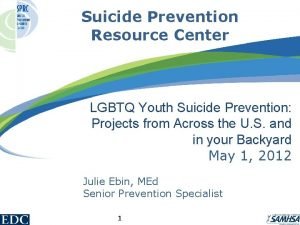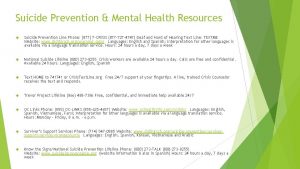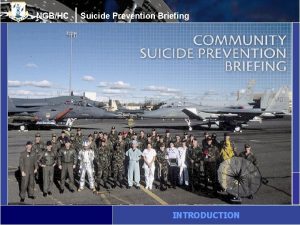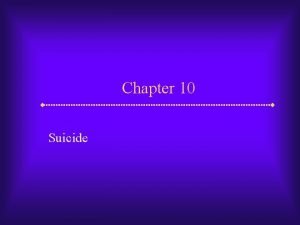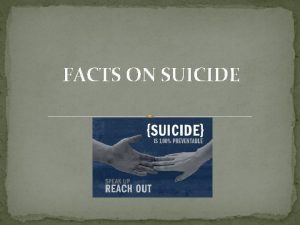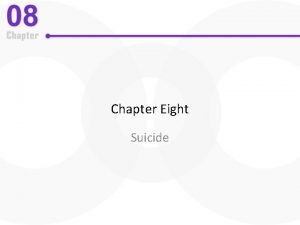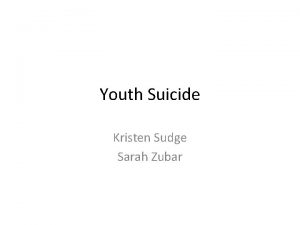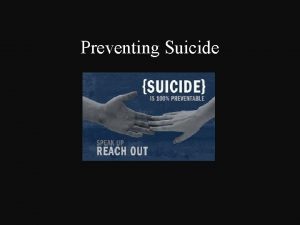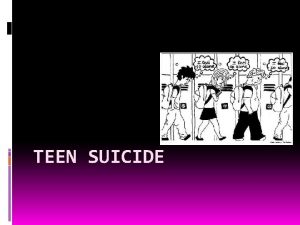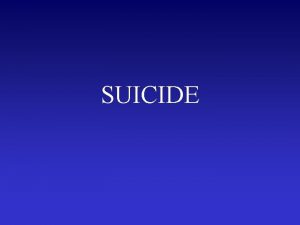SOS Signs of Suicide Prevention Program Implementing an


































































- Slides: 66

SOS Signs of Suicide Prevention Program Implementing an Evidence-based Suicide Prevention Program in Your School

Screening for Mental Health and SOS SMH is a national non-profit organization whose mission is to provide innovative mental health and substance abuse resources, linking those in need to quality treatment options. The SOS Signs of Suicide® Prevention Program is an award-winning, evidence-based educational and screening tool used in middle and high schools across the country.

What we will cover today: 1. Youth suicide ▫ ▫ National and local statistics Risk factors and warning signs 2. What can schools do? ▫ Implementing an evidence-based, universal prevention program 3. Q&A

Taking a Closer Look at Youth Suicide A public health crisis for our youth

Myths and Facts MYTH: Talking to students about suicide or asking a student if they are suicidal is risky because it might put the idea in their head. FACT: • You don't give a suicidal person morbid ideas by talking about suicide. • The opposite is true. Bringing up the subject of suicide and discussing it openly is one of the most helpful things you can do.

Myths and Facts MYTH: If a person is determined to kill themselves, there isn’t much that can be done to stop them. FACT: • Even the most severely depressed person has mixed feelings about death, wavering until the very last moment between wanting to live and wanting to die. • Most suicidal people do not want death; they want the pain to stop. The impulse to end it all, however overpowering, does not last forever.

True or False? 1 in 20 adolescents have a diagnosable mental health disorder = False 1 in 5 adolescents have a diagnosable mental health disorder. Approximately 1/3 of mood disorders, such as depression, first emerge during adolescence (Kessler et al. , 2005) Approximately 50% of adolescents with a psychiatric disorder receive treatment = False Less than half of the adolescents with a psychiatric disorder received any kind of treatment in the past year (Costello et al. , 2013) The prevalence of depression in adolescents and young adults is increasing = True The prevalence of depression in adolescents and young adults increased from 8. 7% in 2006 to 11. 3% in 2014 (Mojtabai et al. , 2016) Suicide is the 3 rd leading cause of death among 11 -18 year olds = False Suicide is the 2 nd leading cause of death among 11 -18 year olds (CDC, 2015)

Suicide Risk for Children 10 -14 • Recent data shows rates of suicide going up for 10 -14 year olds (CDC, 2016)

US Stats vs. Georgia Stats 2013 - YRBS Behaviors that Contribute to Unintentional Injuries and Violence GA Students US Students Seriously considered attempting suicide (within previous 12 months) 14. 3% 17% Made a plan about how they would attempt suicide (within previous 12 months) 12. 2% 13. 6% Attempted suicide (one or more times within previous 12 months) 8. 8% 8% Attempted suicide that resulted in injury that needed to be treated by a doctor or nurse (within previous 12 months) 3. 4% 2. 7%

Georgia Health Survey • Anonymous and self-reported • Results available: http: //www. gadoe. org/Curriculum. Instruction-and-Assessment/Curriculum-and. Instruction/GSHS-II/Pages/GSHS-Results. aspx • Each school and school district receives a comprehensive report that allows administrators to compare outcomes and plan accordingly • Compare the data from their schools/ districts to other schools and school districts as well as state data and with national data from the Youth Risk Behavior Survey (YRBS)

Percentage of students who strongly agree that they feel connected to others at school 100% 90% 80% 70% 60% 50% 45% 42% 40% 38% 30% 26% 25% 20% 10% 0% 6 th grade 7 th grade 8 th grade 9 th grade 10 th grade 11 th grade 12 th grade Georgia

Percentage of students who strongly agree that adults in this school treat all students with respect 100% 90% 80% 70% 60% 50% 47% 40% 35% 29% 30% 25% 20% 19% 20% 10% 0% 6 th grade 7 th grade 8 th grade 9 th grade Georgia 10 th grade 11 th grade 12 th grade

Percentage of students who strongly agree that they know an adult in the school they can talk to if they need help 100% 90% 80% 70% 60% 51% 50% 47% 39% 40% 38% 42% 30% 20% 10% 0% 6 th grade 7 th grade 8 th grade 9 th grade 10 th grade 11 th grade 12 th grade Georgia

Percentage of students who strongly agree that they know a student they can talk to at school if they’re feeling sad or down 100% 90% 80% 70% 60% 58% 56% 51% 49% 48% 40% 30% 20% 10% 0% 6 th grade 7 th grade 8 th grade 9 th grade 10 th grade 11 th grade 12 th grade Georgia

Identifying Students In Need Risk factors and warning signs, how we can help!

Risk Factors A risk factor is a personal trait or environmental quality that is associated with increased risk of suicide. Risk factors ≠ causes • Over 90% of people who die by suicide have a least one major psychiatric disorder (Brent, 1999) • The strongest risk factor for suicide in youth: depression ▫ Can occur in teens who seem to “have it all” ▫ Down mood can look more like anger and irritability in teens ▫ Often expressed in physical complaints from teens (stomach distress, headaches, fatigue) • Although most depressed people are not suicidal, most suicidal people are depressed.

Populations At Elevated Risk • • • Alcohol or drug use Non-suicidal self injury or previous suicide attempt Homeless or out-of-home settings LGBTQ Medical conditions or disability Impacted by suicide

Precipitating Event • A precipitating event is a recent life event that serves as a trigger, moving an individual from thinking about suicide to attempting to take his or her own life. • No single event causes suicidal behavior; other risk factors are typically present • Examples: ▫ ▫ breakup bullying incident sudden death of a loved one trouble at school

Warning Signs A warning sign is an indication that an individual may be experiencing depression or thoughts of suicide. Most individuals give warning signs or signals of their intentions. Seek immediate help if someone makes a direct threat, is actively seeking means, or is talking/writing about death. Other warning signs to take seriously: ▫ Risky behavior, recklessness, non-suicidal self injury ▫ ↑ substance use ▫ ↓ interest in usual activities ▫ Withdrawal ***Be aware of significant changes in your students – in their affect, behavior, appearance, attendance, etc. ***

Basic Steps to Ensure Safety If you see warning signs, take the following steps right away: • Supervise the student constantly (or make sure the student is in a secure environment supervised by caring adults) until he or she can be seen by the mental health contact. • Escort the student to see the mental health contact or administrator. • Provide any additional information to the mental health professional evaluating the student to help in the assessment process. That person will notify the student’s parents.

Suicide: A Multi-Factorial Event Psychiatric Illness Comorbidity Neurobiology Impulsiveness Personality Disorder/Traits Hopelessness Family History Suicide Substance Use Psychodynamics/ Psychological Vulnerability Severe Medical Illness Access to Weapons Life Stressors Suicidal

Applying Our Knowledge Preparing to support students in need

Student Bio: Margaret • Margaret, a very sweet and social 8 th grade student recently lost her aunt to suicide and has been treated for anxiety in the past. She is very active and competitive with the debate team. In the last month you’ve seen her grades drop dramatically, she’s missed 3 days of school (which is unusual) and she’s been seen crying in the bathroom. Today you just found out that her boyfriend broke up with her. Risk Factors Warning Signs Protective Factors • Family history (aunt’s death) • Other mental health issues • Grades dropping • Missing school • Crying in the bathroom • She’s social (personality trait) • Active in debate club Precipitating Event • Breakup

How Would You Reach Out To Margaret? • Mention changes you have noticed her behavior and that you are concerned and ask how she is doing • Ask if they have been thinking about suicide, e. g. , “Are you feeling so bad that you’ve thought about suicide? ” • Be supportive, remain calm, show that you care and reassure her that help is available • Escort her to talk to her counselor/school mental health contact • Your job is not over! ▫ Continue to check in with her ▫ Talk to the school’s mental health contact/administrator about your concerns

ACT To Help a Student In Need Acknowledge that you are seeing signs of depression or suicide in a student and that it is serious Care: Let the student know you care about them and you can help Tell: Follow your school protocol and tell your mental health contact

ACT Script Acknowledge: “It sounds like you’re really hurting. Are you feeling so bad that you’ve thought about suicide? ” Care: “I’m really concerned about you trying to deal with all of this on your own. ” Tell: “There are people at school who know how to help kids that are dealing with big issues like this, let’s walk down to the counseling suite together. ”

Managing Your Reactions Avoid: Remember: • Arguing with the student about their feelings or choices. • You don’t need to be the expert or have all the answers. • Minimizing the student’s feelings. • Give yourself permission to be human. It’s normal to feel anxiety or other difficult feelings. • Keeping what you learn a secret. • Talk to a supportive person beforehand debrief afterward. There is no perfect script for talking about suicide. Simply show the student that you care and get help.

ACTivity: Practice Responding Acknowledge: that you are seeing signs of depression or suicide in a student and that it is serious Care: Let the student know you care about them and you can help Tell: Follow your school protocol and tell your mental health contact

ACTivity: Ross Practice responding to youth using the ACT message: One of your students, Ross, used to excel in your class. He was one of the top students in his grade but recently his grades have begun to slip and he seems distracted. You speak to some of your colleagues and learn that his grades have been dropping across the board. When you decide to speak to him after class, he tells you that he “doesn’t care about school anymore. ” You press a little to understand more and he reveals “that he doesn’t see the point in any of it anymore. ”

What Can Schools Do? Building protective factors, universal prevention, SOS Program

Building Protective Factors Protective factors are personal traits or environmental qualities that can reduce the risk of suicidal behavior. Protective factors ≠ immunity, but help reduce risk • Individual Characteristics ▫ (adaptable temperament, coping skills, self-esteem, spiritual faith) • Family/Other Support ▫ (connectedness, social support) • Mental Health and Healthcare ▫ (destigmatized mental health, access to care, support through medical/mental health relationships) • Restricted Access to Means ▫ (firearms/medications/alcohol, safety barriers for bridges) • School ▫ (positive experience, connectedness, sense of respect)

Universal Suicide Prevention Goals • Decrease suicide and attempts by increasing knowledge and adaptive attitudes about depression. • Encourage individual help-seeking and help-seeking on behalf of a friend. • Reduce stigma: mental illness, like physical illness, requires treatment. • Engage parents and school staff as partners in prevention through education. • Encourage schools to develop community-based partnerships.

SOS Program Components Peer-to-Peer Student Program: • DVDs, discussion guides, newsletters and supplementary materials provided for the evidence-based SOS Program. Screening: • A validated, seven-item Brief Screen for Adolescent Depression (BSAD) designed to identify at-risk students for further evaluation. Screening forms are educational in nature and do not take the place of a formal diagnosis.

SOS Program Components Implementation guide Student video & discussion guide BSAD screening forms Student response cards Student newsletters Parent newsletters Wallet cards, stickers, posters Training video & discussion guide Online training module Life Teammates toolkit for coaches • Downloadable materials and Forms • • •

Evaluation of the SOS Program SOS is the only universal school-based suicide prevention program for which a reduction in self-reported suicide attempts has been documented. In randomized controlled studies, the SOS Program has shown a reduction in self-reported suicide attempts by 40 -64%. A new replication study published in the Prevention Science Journal (2016) found SOS to be associated with: • greater knowledge and more adaptive attitudes about depression and suicide • 64% fewer suicide attempts among intervention youths relative to untreated controls • decrease in suicide planning for “high risk participants” (those who reported a lifetime history of suicide attempt) (Schilling et. al, 2016)

Reducing Liability for Schools that implement solid suicide prevention programs and procedures: • Greatly reduce risk of liability • Follow the legal duty to care for students • Have the best chance of saving lives Provide (and document) crisis training for all school personnel Implement (and document) suicide prevention programming, appropriate interventions and postvention efforts -Suicide In Schools: A Practicioner’s Guide to Multi-level Prevention, Assessment, Intervention, and Postvention, 2015

Reducing Liability for School Mental Health Professionals • Maintain liability insurance: nurses, social workers, psychologists, and counselors should carry individual malpractice insurance • Seek supervision from colleagues: always consult with other trained professionals to ensure that the best care of a student is being taken • Keep good records: prioritize thorough documentation as it will become evidence in court -Suicide In Schools: A Practicioner’s Guide to Multi-level Prevention, Assessment, Intervention, and Postvention, 2015

SOS Program in Action Day of the Program

On the Day of the Program: 1. Introduce program 2. Show video 3. Facilitate discussion 4. Students complete screening forms and student response cards 5. Set expectation about when follow-up can be expected; provide referral information 6. Follow up with students requesting help/ screening in

Friends for Life Video & Activity • View the Friends for Life video • Choose one person at your table to lead the discussion • Act like your high school students during the discussion • Choose a reporter to share with the group: − What was the hardest question to answer? − How comfortable did you feel discussing the topics in the DVD? − How can you best prepare to deliver this program to students?

Identifying Students In Need Students are identified 3 ways: • Screening • Student response card • Help-seeking: students ACT and tell a trusted adult (teachers, coaches, parents) BASED ON THE VIDEO AND/OR SCREENING, I FEEL THAT: □ I need to talk to someone … □ I do not need to talk to someone … ABOUT MYSELF OR A FRIEND. NAME(PRINT): _________________ HOMEROOM SECTION: _____________ TEACHER: ___________________ IF YOU WISH TO SPEAK WITH SOMEONE, YOU WILL BE CONTACTED WITHIN 24 HOURS. IF YOU WISH TO SPEAK WITH SOMEONE SOONER, PLEASE APPROACH STAFF IMMEDIATELY.

Brief Screen for Adolescent Depression (BSAD)

How Many Students Will Need Follow-up?

Screening and Student Response Card 16% 15% 14% 12% 11% 10% 9% 8% 8% 7% 6% 4% 4% 4% 3% 2% 0% 2% 2% 1% 0% Student Response Card ONLY Screened in Screening without Student Response Card Came forward for SELF Came forward for FRIEND Screening with Student Response Card Total identified for followup

Screening: Anonymous vs. Identified Identifying students in need • Identified screening provides a simple way for students to reach out • Anonymous screening encourages students to self-score and then take an additional step of seeking help Time and resources • Identified screening requires staff to review all forms on the day of the program • Some schools require all students to meet with their counselor if conducting anonymous screening

Student Mental Health Screening • It is important to convey to students and parents that the mental health screenings being conducted in your school are for educational purposes • Screenings are informational, not diagnostic - Diagnoses, treatment recommendations and opinions should not be given • The goal of the screening is to identify students with symptoms consistent with depression and/or suicidal risk and to advise a complete professional evaluation • There is no evidence that screening youth for suicide induces suicidal thinking or behavior.

Best Practices in Student Screening • Protect student privacy by collecting forms individually and using discretion when following up with students (tip: announce that you will also follow up with students randomly for feedback) • Make team decisions • Prompt disclosure of a suicide threat to a parent is both legal and prudent • Document steps taken and recommendations given (a sample student follow-up form is provided) • Confidential materials should be stored under lock and key • Always consult with the school legal department for questions regarding policies

Advice on Follow Up “A lot more kids come forward but that’s what you want. It’s happening anyway. We’re not creating anything, we’re just trying to bring it to the surface so we can help. ” (J. Gagnon) Some schools utilize a color-coded system to score the BSADs by priority: − Red: need to follow up with today − Orange: need to follow up within 48 hours − Yellow: need to follow up within a week − Green: good to go

Student Follow-Up ACTivity • In groups, score the sample BSAD screening forms and response cards for students A-G ▫ Which students require follow-up? ▫ Which students would you want to see first? Why? ▫ Besides referral for mental health assessment/treatment, what other follow-up might be appropriate for these students?

Planning for Universal Prevention Ensuring you’re ready for the SOS Program

Planning Step-by-Step 1. Identify and train implementation team 2. Scheduling and logistics 3. Prepare for follow up with students in need 4. Train the trusted adults: including staff and parents 5. Implement!

1. Identify and Train Team • Who should be on the implementation team? ▫ ▫ Who are the key mental health staff in your district? Who are your advocates in the school? Are there outside agencies that can assist with day of implementation? Who else? • Define roles and responsibilities of team members ▫ ▫ Prior to program implementation On the day of Immediately after Year-round • Utilize Training Trusted Adults DVD and/or Plan, Prepare, Prevent 90 -minute online module to help prep team • Familiarize yourselves with student video, discussion guide, screening forms, etc.

2. Scheduling and Logistics • Dates and times for SOS Program ▫ Time for follow-up • Student population to be served ▫ Pilot groups ▫ Integration into curriculum • Classroom setting ▫ Avoid large assemblies/presentations • Alternate settings available ▫ For those who need to step out or opt out of program • Review and update school policies for handling suicidal disclosure, parental consent, record keeping, etc. ▫ Model School Policy https: //afsp. org/wp- content/uploads/2016/01/Model-Policy_FINAL. pdf

3. Prepare for Follow Up • Use SAMHSA’s Find Treatment Locator to identify additional referral resources: https: //findtreatment. samhsa. gov/ • Contact local mental health facilities and verify their referral procedures, wait lists, insurance details, etc. • Create a referral resource list to send with parent letter • Identify in advance who will be handling emergencies • Notify the nearest crisis response center about the program in advance in order to facilitate referrals

4. Train, Faculty, Staff and Parents • Engage school’s mental health staff to discuss risk factors, warning signs and how to identify students in need • Discuss the connection between depression and suicide and dispel myths about youth suicide (use Training Trusted Adults video and discussion guide) • Review best practices for responding to youth at-risk • Discuss confidentiality: An adult must never keep a secret for a child if there is any concern about safety • Review school policy for following up with at-risk students, including how and when parents/guardians will be contacted if their child needs further help • Allow time for questions

Suggestions for a Parent Night • How can your school attract parents for a parent night? ▫ Make it fun and accessible: offer food, transportation, giveaways and/or childcare ▫ Pair with a mandatory event (parent teacher conferences) or fun event (science fair, game, play) ▫ Give it an accessible name: “Safeguarding our Youth” or ”Keeping our Kids Safe”

Engaging Parents Using active parental consent: “Most parents provide consent. Those that don’t usually just don’t understand the program, so I contact them and explain it, which helps get consent from almost everyone. It’s a great chance to reach out and connect with parents. ” (L. Morales) Using passive consent: In 2015 -2016, we surveyed schools around the nation and found that 86% of middle and high schools use passive consent.

Resources For Your Trainings • SOS Online Training Module, visit: ▫ ▫ www. sosplanprepareprevent. org Certificate of Completion available for all learners • Training Trusted Adults DVD • SOS Program Implementation Guide • SMH Staff (contact us!)

Let’s Review- SOS Program in 10 Steps 1. Identify and train implementation team 2. Work with administration to update policies and schedule program 3. Work with community partners to gather referral resources 4. Train faculty and staff to be Trusted Adults 5. Outreach to parents 6. Implement SOS! �Video and discussion �BSAD screening �Student response card 7. Follow up with students requesting help/ screening in 8. Contact parents, refer for further assessment, etc. as needed 9. Document all suicide prevention/intervention activities (Student follow-up form provided) 10. Plan for next year

Questions? “One social worker we worked with met with a student who had been screened in after the program. He kept asking her: ‘But why did you do this program today? ’ Turns out he had planned to take his life that afternoon. They saved this boy. We are identifying kids and saving lives. ”

Next Steps • Please complete an electronic evaluation (you will receive a certificate of completion) • Free SOS Programs available! Complete application with your administrator’s approval and a brief plan for how you will use the program • Trainings available- contact me

For More Information Contact: Meghan Diamon, Senior Manager of Suicide Prevention Programs mdiamon@mentalhealthscreening. org Screening for Mental Health, Inc. One Washington Street, Suite 304 Wellesley Hills, MA 02481 P: 781. 239. 0071 F: 781. 431. 7447 www. Mental. Health. Screening. org

Copyright 2017 by Screening for Mental Health, Inc. All rights reserved. Printed in the United States of America. This presentation is intended for non-commercial use by registered facilities for the SOS Signs of Suicide® Prevention Program. Reproduction or other use of this manual without express written consent of Screening for Mental Health, Inc. is forbidden.

References Kessler, R. C. , Berglund, P. , Demler, O. , Jin, R. , Walters, E. E. 2005. Life-time prevalence and age-of-onset distribution of DSM-IV disorders in the national co-morbidity survey replication. Archives of General Psychiatry, 62, 593 -602. Rushton, J. L. , Forcier, M. , Schectman, R. M. 2002. Epidemiology of depressive symptoms in the national longitudinal study of adolescent health. Journal of the American Academy of Child and Adolescent Psychiatry, 4, 199 -205. Brent DA, Baugher M, Bridge J, Chen T, Chiappetta L (1999), Age- and sex related risk factors for adolescent suicide. J Am Acad Child Adolesc Psychiatry 38: 1497– 1505 Mojtabai, R. , Olfson, M. , Han, B. (2016). National Trends in the Prevalence and Treament of Depression in Adolescents and Young Adults. American Academy of Pediatrics, 138 (6), Retrieved on 11/17/2016 http: //pediatrics. aappublications. org/content/early/2016/11/10/peds. 2016 -1878 Centers for Disease Control. (2016) Quick. Stats: Death Rates for Motor Vehicle Traffic Injury, Suicide, and Homicide Among Children and Adolescents aged 10– 14 Years — United States, 1999– 2014. MMWR Morb Mortal Wkly Rep 2016; 65: 1203. DOI: http: //dx. doi. org/10. 15585/mmwr. mm 6543 a 8. Greenberg, M. , Weissberg, R. , O’Brien, M. , Zins, J. E. , Fredericks, L. , Resnik, H. , Elias, M. J. (2003). Enhancing school-based prevention and youth development through coordinated social, emotional, and academic learning. American Psychologist, 58(6/7), 466 -74. National Alliance of Mental Illness (NAMI). (2003). Depression in children and adolescents. Retrieved from http: //www. nami. org/Template. cfm? Section=By_Illness&template=/Content. Management/Content. Display. %20 cfm&Content. ID=17623 U. S. Department of Health and Human Services. Mental Health: A Report of the Surgeon General. Rockville, MD: U. S. Department of Health and Human Services, Substance Abuse and Mental Health Services Administration, Center for Mental Health Services, National Institutes of Health, National Institute of Mental Health, (1999). U. S. Public Health Service. Report of the Surgeon General’s Conference on Children’s Mental Health: A National Action Agenda. Washington, D. C. , Department of Health and Human Services, (2000). Centers for Disease Control and Prevention (CDC). (2013, June 13). Youth Risk Behavior Surveillance — United States, 2013. MMRW. Morbidity and Mortality Weekly Report. Retrieved from http: //www. cdc. gov/mmwr/pdf/ss/ss 6304. pdf

References Centers for Disease Control and Prevention (CDC) National Center for Injury Prevention and Control. Web-based Injury Statistics Query and Reporting System (WISQARS). Retrieved from: www. cdc. gov/ncipc/wisqars Gould, M. , Greenberg, T. , Velting D. M. , Shaffer, D. (2003). Youth suicide risk and preventive interventions: A review of the past 10 years. Journal of the American Academy of Child and Adolescent Psychiatry, 42(4), 386 -405. Costello, E. J. , He, J. P. , Sampson, N. A. , Kessler, R. C. , & Merikangas, K. R. (2013). Services for adolescents with psychiatric disorders: 12 -month data from the National Comorbidity Survey–Adolescent. Psychiatric Services, 65(3), 459. Substance Abuse and Mental Health Services Administration. (2012). Results from the 2010 National Survey on Drug Use and Health: Mental Health Findings, NSDUH Series H-42, HHS Publication No. (SMA) 11 -4667. Rockville, MD: Substance Abuse and Mental Health Services Administration. Schilling, E. A. , Aseltine, R. H. , Glanovsky, J. K. , James, A. , Jacobs, D. (2009). Adolescent alcohol use, suicidal ideation, and suicide attempts. Journal of Adolescent Health, 44, 335 -41. Walsh, B. (2012). Treating self-injury: A practical guide, 2 ND Edition. New York: Guilford. Bulik, C. M. , Thornton, L. , Pinheiro, A. P. , Plotnicov, K. , Klump, K. L, Brandt, H. , . . . , Kaye W. H. (2008). Suicide attempts in anorexia nervosa. Psychosomatic Medicine, 70(3), 378 -83. Centers for Disease Control and Prevention (CDC), National Center for Injury Prevention and Control. Web-based Injury Statistics Query and Reporting System (WISQARS). Retrieved from: www. cdc. gov/ncipc/wisqars Suicide Prevention Resource Center. (2013). Suicide among racial/ethnic populations in the U. S. : Asians, Pacific Islanders, and Native Hawaiians. Waltham, MA: Education Development Center, Inc.

References Kosciw, J. G, . Gerytak, E. A. , Bartkiewicz, M. J. , Boesen, M. J. , Palmer, N. A. (2011). The 2011 national school climate survey. New York, NY: GLSEN Centers for Disease Control and Prevention National Center for Injury Prevention and Control. (2014, April). The relationship between bullying and suicide: what we know and what it means for schools. Retrieved from: http: //www. cdc. gov/violenceprevention/pdf/bullying-suicide-translation-final-a. pdf UCLA Center for Mental Health in Schools. School community partnerships: a guide. Retrieved from http: //smhp. psych. ucla. edu/pdfdocs/guides/schoolcomm. pdf Aseltine, R. , James, A. , Schilling, E. A. , Glanovsky, J. (2007). Evaluating the SOS suicide prevention program: A replication and extension. BMC Public Health, 7, 161. Aseltine Jr. , R. H. & De. Martino, R. (2004). An outcome evaluation of the SOS suicide prevention program. American Journal of Public Health, 94(03), 446 -51. Gould, M. S. , Marrocco, F. A. , Kleinman, M. , Thomas, J. G. , Mostkoff, K. , Cote, J. , Davies, M. (2007). Evaluating Iatrogenic risk of youth suicide screening programs. American Medical Association, 293(13), 1635 -43. The Trevor Project. (2014). Model school district policy on suicide prevention: model language, commentary, and resources. Retrieved from http: //b. 3 cdn. net/trevor/a 9 d 03 d 1 c 0564014 cfe_61 m 6 bzr 84. pdf UCLA Center for Mental Health in Schools. School community partnerships: a guide. Retrieved from http: //smhp. psych. ucla. edu/pdfdocs/guides/schoolcomm. pdf Erbacher, E. A. , Singer, J. B. , Poland, S. (2015). Suicide in schools: A practioner’s guide to multi-level prevention, assessment, intervention, and postvention. New York: Routledge.
 Primary prevention secondary prevention tertiary prevention
Primary prevention secondary prevention tertiary prevention Sign shapes meaning
Sign shapes meaning Mad acronym suicide prevention
Mad acronym suicide prevention Glencoe health chapter 5
Glencoe health chapter 5 Suicide chain teach
Suicide chain teach Texas suicide prevention symposium
Texas suicide prevention symposium Mental health faucets
Mental health faucets Army suicide prevention situational questions
Army suicide prevention situational questions Prévention du suicide
Prévention du suicide Suicide prevention month quotes
Suicide prevention month quotes Army suicide prevention training
Army suicide prevention training Bipolaire suicide
Bipolaire suicide Signs og safety
Signs og safety Accident prevention signs and tags
Accident prevention signs and tags Accident prevention signs and symbols
Accident prevention signs and symbols Osha safety signs and symbols
Osha safety signs and symbols Difference between natural and conventional signs
Difference between natural and conventional signs Railroad signs and meanings
Railroad signs and meanings The diamond shape is used exclusively for _____ signs
The diamond shape is used exclusively for _____ signs Payment error prevention program
Payment error prevention program Kansas eviction prevention program application
Kansas eviction prevention program application Hazard prevention program
Hazard prevention program Diabetes prevention program outcomes study
Diabetes prevention program outcomes study Needle stick injury
Needle stick injury Diabetes prevention program ppt
Diabetes prevention program ppt Identity theft prevention program
Identity theft prevention program Counterfeit parts prevention program as5553
Counterfeit parts prevention program as5553 Alberta screening and prevention program
Alberta screening and prevention program Suicide girls colombia
Suicide girls colombia Citadel counseling center
Citadel counseling center Youth suicide research consortium
Youth suicide research consortium Rvguev suicide
Rvguev suicide Bab 20
Bab 20 Egoistic suicide
Egoistic suicide Social integration by emile durkheim
Social integration by emile durkheim The sad persons scale
The sad persons scale Why people die by suicide joiner
Why people die by suicide joiner Lcps suicide
Lcps suicide Break up suicide
Break up suicide Suicide inhibitor
Suicide inhibitor Digestive enzymes and their functions table
Digestive enzymes and their functions table Dr. spock's son committed suicide
Dr. spock's son committed suicide Slap suicidality
Slap suicidality Detergent suicide ingredients
Detergent suicide ingredients Dr. thomas jentges suicide
Dr. thomas jentges suicide Detergent suicide
Detergent suicide Articles funéraires drusenheim
Articles funéraires drusenheim Livi jaay suicide
Livi jaay suicide Murder suicide moorpark
Murder suicide moorpark Dr maria suicide
Dr maria suicide Desitter suicide
Desitter suicide Suicide chateau suscinio
Suicide chateau suscinio Zero suicide
Zero suicide St joeys suicide
St joeys suicide Mrs dalloway summary
Mrs dalloway summary Cams suicide assessment
Cams suicide assessment Permanent solution
Permanent solution Risicofactoren suicide
Risicofactoren suicide Risicofactoren suicide
Risicofactoren suicide Sad person score
Sad person score Angie verona nude
Angie verona nude Thomas joiner suicide
Thomas joiner suicide 988 suicide
988 suicide Hitler suicide
Hitler suicide Ethical issues in nursing education
Ethical issues in nursing education Types of suicide
Types of suicide Dead sociologists
Dead sociologists





